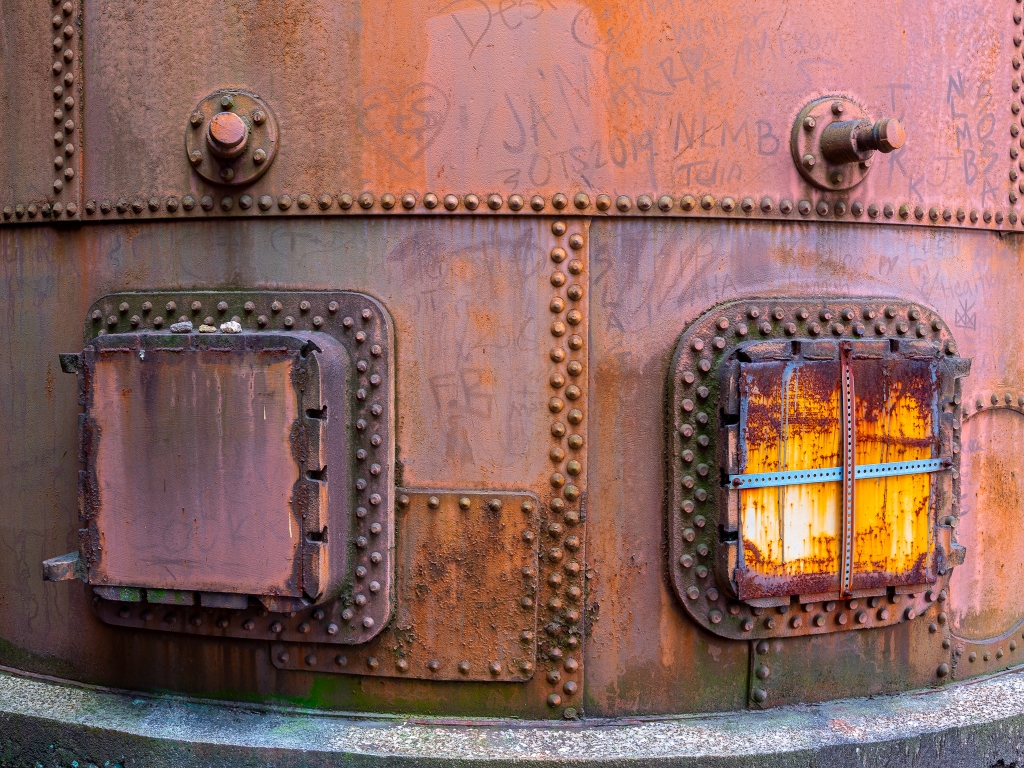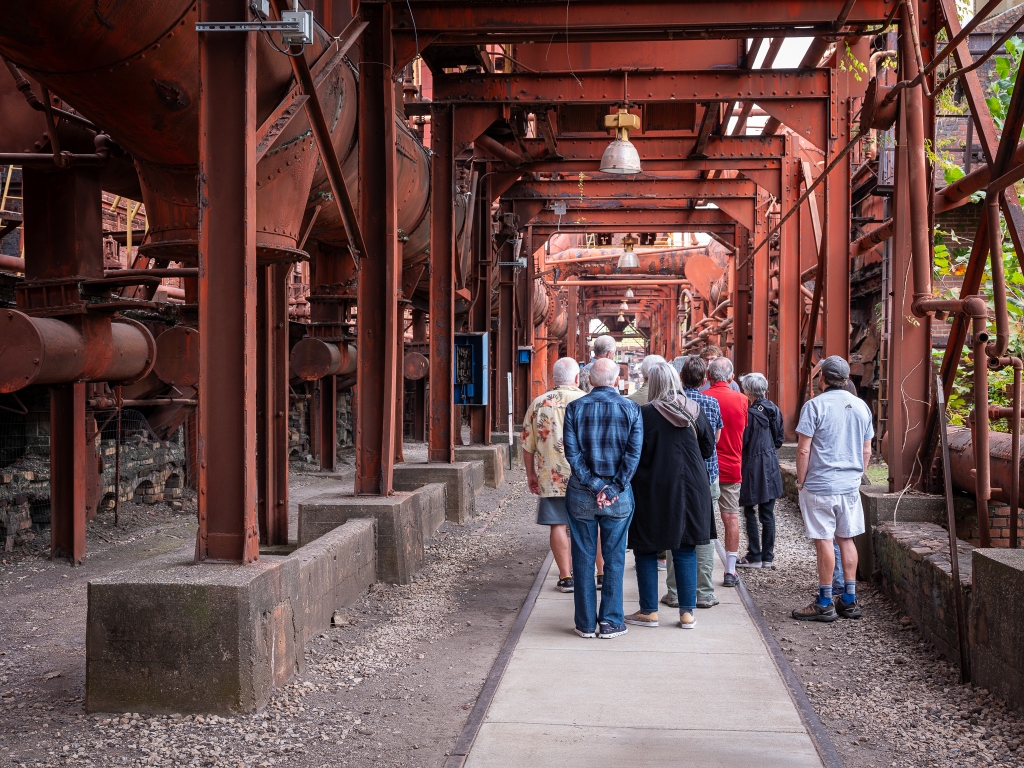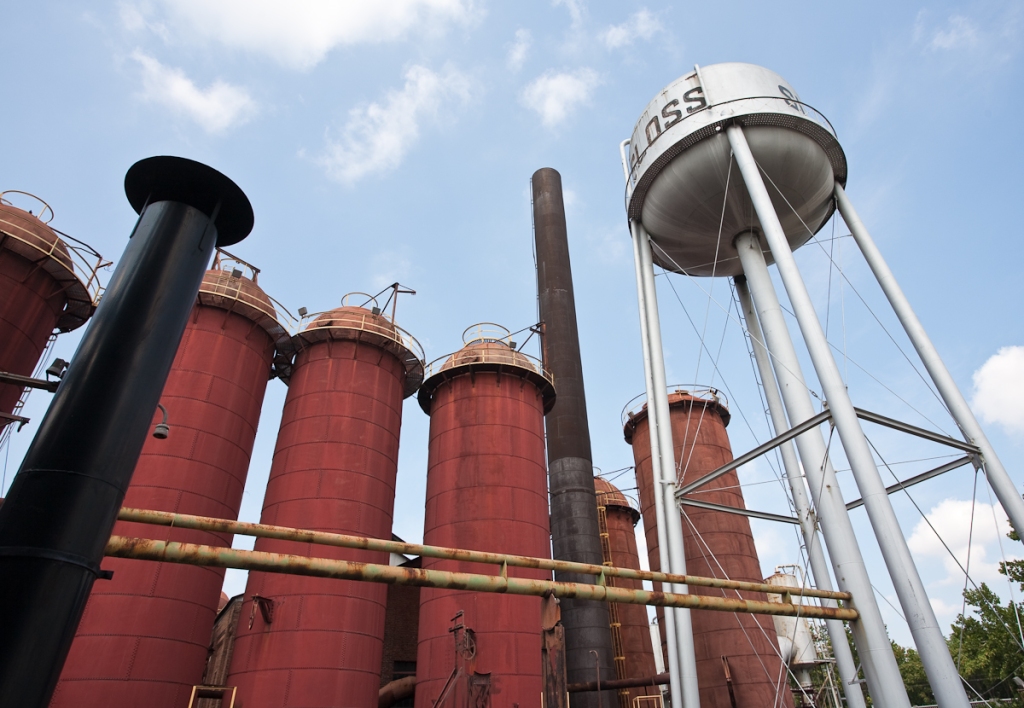The Sloss Furnaces
Recently, I revisited one of my favorite places in Alabama. It seems like an odd attraction to consider a favorite, but nevertheless it is. I mean, at its basic level, it is mainly a rusting relic to a bygone era in the history of the Yellowhammer state. The Sloss Furnaces are located just a stone’s throw from bustling downtown Birmingham. The Sloss is the site of the blast furnace plant where pig iron was made for nearly 100 years, and it is the only industrial complex of its type currently being preserved as a museum in the U.S. The rusting collection of blast stoves, smokestacks and furnaces are all that remain to tell the story of a once thriving business that employed thousands of people.
The history of the Sloss Furnaces begins in the latter part of the 19th Century when it was discovered that Birmingham possessed all that was needed to produce quality pig iron. Iron ore, coal and limestone are the basic ingredients required to make pig iron, and Birmingham had rich deposits of all three nearby. In 1882, James Withers Sloss built two blast furnaces on the city’s east side. Along with the competing Alice Furnaces on the city’s west side, Birmingham quickly grew into the mighty industrial center of the new South.
As time passed, the furnaces had to be rebuilt to keep up with technology and new buildings were added to the site such as the blowing engine house. Additional stoves, boilers and other equipment were added to keep up with quickly changing industry standards.
The original furnaces were replaced with the ones which are currently on the site. Improvements made during this period included electrical power and a new mechanical loading system for the iron ore, coking coal and limestone needed for the process. Currently, nothing remains of the original furnace complex and the oldest building dates to 1902.
As ownership the furnaces changed hands throughout the years, its name changed but not its function. By the early 1950’s, the Sloss was called the Sloss-Sheffield Steel and Iron Company although it never made steel. It’s owner was now the United States Pipe and Foundry Company, but it would change hands again in 1969. The Jim Walter Company acquired the complex and ultimately deeded the property to the Alabama State Fair Association with the intention that the Sloss would be preserved as a museum.
That idea didn’t gain much traction though, and the Sloss Furnaces was ultimately slated for destruction. That was until a group of Birmingham residents formed the Sloss Furnace Association in an effort to preserve the historic site. Voters passed a bond referendum to raise the needed funds for the preservation of the Sloss while transitioning it from a decaying industrial complex to a living museum.
Initially, the effort to keep the Sloss away from the wrecking ball was in doubt, that is, until the United States Department of the Interior designated the Sloss Furnaces as a National Historic Landmark. Once proponents of the preservation of the Sloss had the national spotlight on it, the project garnered the support needed to proceed. On Labor Day, in 1983, the Sloss Furnaces was opened to the general public.
As I mentioned, the Sloss Furnaces is one of my favorite places in Alabama. I think that is because it offers so many different and unique photographic possibilities. It is one of the most popular sites for all types of photographers; wedding, portrait, urban or general subject. It is so popular with wedding and fashion photographers, that the Sloss charges a fee as a way to manage the many requests, and to generate a bit of extra needed funding. Since my last visit to the Sloss, a beautiful new visitors center has been built, which includes a gift shop, auditorium and administrative offices. The Sloss operates metal arts classes and other educational programs year round. As mentioned, it is a popular wedding venue and a site for music concerts.
The history of the Sloss is not the only thing that draws me back time and again. The 18-acre site has a distinct abandoned quality that cries out to be photographed. It’s almost spooky. The fact is, the Sloss is one of the top places in the world for paranormal activity research, and has attracted ghost hunters from all over the globe. I can’t say that I have witnessed any shadowy figures myself, but I’ll admit that I’ve felt uneasy there at times. So, consider this a warning if you are planning a visit to the Sloss Furnaces. Take a friend.
The Sloss Furnaces is open Tuesday thru Saturday from 10am – 4pm. It is located at 20 32nd Street North, Birmingham, AL 35222.
Sloss Furnaces Redux
Back in January, I had an opportunity to visit the Sloss Furnaces for the first time. I posted my impressions in this blog on (1/10/10). This past week, a photographer-friend of mine invited me back down to Birmingham to take another look at this old and historic iron production site. Now, I’ll admit that my first review of the Sloss was less than charitable. I had problems with the fact that the visitor’s center was closed, although, according to the schedule, it should have been open. I never found a functioning restroom, a water fountain or vending machine the entire time I was there. I also found it inconceivable that there were no safety or security personnel on-site. I mean, while the Sloss may be on the list of Alabama’s historic places, it is one giant accident waiting to happen. In spite of all that, the Sloss somehow has managed to become one of Birmingham’s most sought after venues for concerts, weddings, art shows and street fairs. In fact, on the morning of my recent visit, a team was setting up for a wedding reception that very evening.
With all the negative vibes I was feeling for the Sloss, I thought that maybe I was being a bit unfair to the old gal. Maybe a second visit, at another time of year, would put the place in a different, more favorable light. The temperatures on the day of my first visit hovered in the low 40’s. This week’s visit was on a day where the high temperature reached 100 degrees. Did I mention that some people were setting up for an outdoor wedding reception later that day? If the groom wasn’t sweating before the ceremony, he certainly would be after it.
The change in temperature didn’t have too much of an impact on my photography. I still function pretty well at both extremes, and fortunately, so does my camera equipment. Surprisingly, there were more visitors at the Sloss on this day, when temps reached the century mark, than back in January when it was in the 40’s. I don’t want to give the impression that there were throngs of visitors, however. The number of people hanging lights and setting up tables and chairs for that wedding, easily outnumbered the tourists on this day. And while those tables and chairs and decorations did effectually render parts of the site off-limits to me, it wasn’t a major inconvenience. Initially, it was a little disconcerting to see white, frilly wedding decorations and candles lining the entire main entrance walkway. If I had wanted an overall panoramic shot of the site I would have been screwed, but fortunately, I had already taken those type shots on my previous visit. On this day, if I wanted a semi-wide shot, I just had to point my lens upward, so as not to include any evidence of the pending wedding celebration down below.
My friend and I spent about three hours winding through the old smokestacks, boilers, and blast furnaces, trying to make art out of steel, cast iron, concrete and glass. Rust is everywhere and the oxidizing paint gives everything a “burnt sienna” patina. The sun kept disappearing behind the clouds, allowing shadows to come and go, giving a couple of different interpretations to everything I chose to photograph.
One has to be a little odd to find beauty in industrial decay. Smokestacks, cast iron pipes, boilers and furnaces are not the subject matter often sought by most artists. Most people just see rust, corrosion and things falling apart. For me, the appeal lies in a couple of things. I appreciate the history of the place. I try to picture the Sloss during its heyday, when it was producing much of the iron fabricated in the South, and I try to imagine the level of activity that must have been here for almost a century. What would it have been like to work here amongst these furnaces, especially on a day as hot as this one? You have to wonder what kind of conditions the workers had to contend with, and how much they earned for their labor. For me, the main appeal of photographing a place like the Sloss, lies in the challenge of finding order in all of the chaos. I look for patterns in the piping and ductwork, the verticals of the smokestacks against the blue sky. Sometimes I’m just looking for textures, or colors, or the play of shadows on a wall. I’ll admit that it’s an odd place to get inspiration, but hey, we photographers are an odd lot to begin with. You know, after a few more visits, I might even begin to like this place.
Tall Buildings and the Law
I was in Birmingham last week to attend, yet another, Photoshop seminar. The seminar was in the evening so I thought I’d arrive early in the day and try to photograph some of the architecture in this state’s largest metropolis. Now, I’ve been to Birmingham a hundred times, most notably when I was a staff photographer for the Huntsville Times. When the University of Alabama played at Legion Field, I could usually be found on the sidelines on any given Saturday capturing the action on film for our football-crazed readers. If it was a night game, I’d only be able to stay for a quarter or till halftime, so I’d have enough time to drive the film back to Huntsville before Sunday presstime. Throughout the years, other stories I worked on, took me to the Magic City (no idea how it got that name), and I became very familiar with many parts of the city. Well, Birmingham has grown quite a bit since those days, so I thought it might be time to take a closer look at some of the city’s newer monoliths.
Once I exited I-65, I headed for downtown and Birmingham’s tallest buildings. These are not necessarily the city’s nicest or most modern buildings, however. In my opinion, most of the nicer, newer, and more modern buildings are located within the numerous office parks along the Hwy 280 corridor, south of downtown. While I did find my way down there later in the afternoon, I concentrated on the downtown area mainly because these buildings are more easily accessible. Many of those office parks are guarded, and getting permission to photograph some buildings on private property is often more trouble than it’s worth.
Unfortunately, photographing the buildings downtown did not come without its own set of problems. No sooner had I mounted the camera on the tripod, then I noticed a policeman approaching me on foot. He came up to me and asked what I was doing. I told him that I was in town for the day, had a seminar to attend that evening, and thought that I would take some new photos to beef up the architectural portion of my photographic website. He said he was mainly just curious and told me not to concern myself with the uniform (easier said than done). He had some questions about my equipment, so I took that to mean, that perhaps, he was a photographer himself. After a couple of minutes, and a few more questions, he said he had to check on his dogs, and he moved toward a car parked nearby. I thought that maybe he was part of a police canine unit, but on considering the ninety degree temperatures, I hoped I had misunderstood him, and that he did not have dogs locked inside a car in that heat.
Within minutes of the policeman’s departure, I was approached by a woman coming from the opposite direction. She introduced herself as a lawyer with the city attorney’s office. She asked my name and wondered just what I was doing. I introduced myself, presented a business card, and again explained what I was up to. She asked if I was aware that I was photographing a federal courthouse. Slightly embarrassed, I had to admit that I did not. From the angle I was shooting, there was nothing that would identify the building as anything other than an ultra-modern, multi-story building. As it turned out, the Hugo Black Federal Courthouse certainly did not look like your typical courthouse, county or federal. The lady lawyer admonished me for taking “unauthorized” photos of a federal building and spouted something about Homeland Security and 9-11. I explained that I was shooting for myself, I was on public property, and that I was only interested in the reflections in the windows on the exterior of the building. Unswayed by my weak explanation, she strongly suggested that I make my way inside the building and inform the U.S. marshals there, that I had been taking photos of their building. She further stated, that she would check up later in the day, to see that I had actually followed through with her unsolicited advice.
As far as I knew, there was no law that said that you could not photograph a federal building, but I thought it prudent to go along with what the lawyer was saying, mainly to get her off my back so that I could go back to shooting. I crossed the street, went inside the building and found a U.S. marshal. I explained my situation and what I had been asked to do by the woman lawyer. I stated my belief that I did not believe photographing a federal building was unlawful, especially from the outside and while standing on public property. The officer seemed a bit unsure of the laws governing photography of federal buildings, but in the end came to the conclusion that it was not permissable, although he admitted that people did it all the time. I felt he was giving me the politically correct answer, and that down deep, I felt, that he didn’t really care. He asked me if I wanted to discuss the matter with his superior, but since no one was suggesting that I surrender my photos, I thanked him and said that would not be necessary. I left Birmingham with all my images and made a mental note, to double-check the laws regarding photographing federal buildings as soon as I got back home. What I found out, was that photography is a form of free speech and expression guaranteed by the first amendment. The general rule is that…………
……….in the United States, anyone may take photographs of whatever they want when they are in a public place or places where they have permission to take photographs. Absent a specific legal prohibition such as a statute or ordinance, you are legally entitled to take photographs. Examples of places that are traditionally considered public are streets, sidewalks, and public parks. One significant exception is certain federal military installations that can prohibit photographs of specific areas when deemed necessary to protect national security.
Kind of what I thought!



























